ID: Bacterial metabolism
1/53
There's no tags or description
Looks like no tags are added yet.
Name | Mastery | Learn | Test | Matching | Spaced |
|---|
No study sessions yet.
54 Terms
during transcription in bacteria, where does the RNA polymerase bind?
Promoter region: a special region of DNA where RNA polymerase binds to initiate transcription from a gene; “-35” and “-10” boxes are two key promoter elements
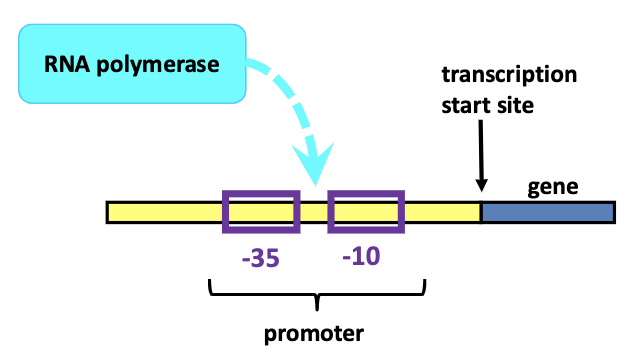
what are strong vs weak promoters?
Strong promoter
RNA polymerase binds well
High levels of transcription
Weak promoter
RNA polymerase binds poorly
Low levels of transcription
what is an operon?
group of genes that are regulated by the same promoter and transcribed as a single mRNA
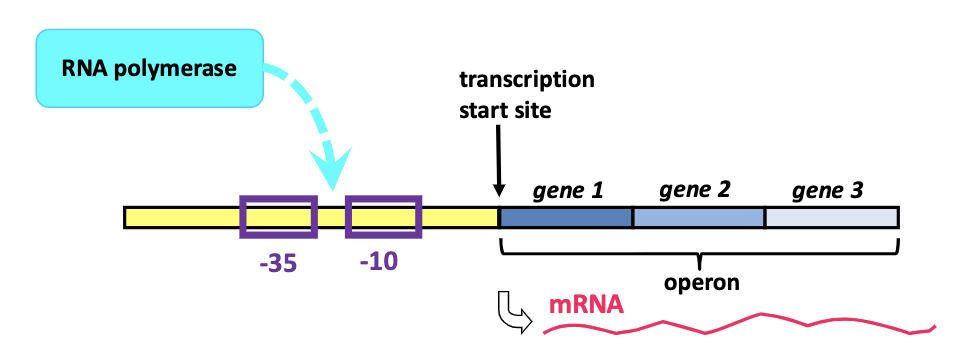
Transcription is controlled by regulators that bind DNA. Specifically…?
Repressors (reduce transcription)
Activators (increase transcription)
where do repressors bind?
binds a region within the promoter region called operator
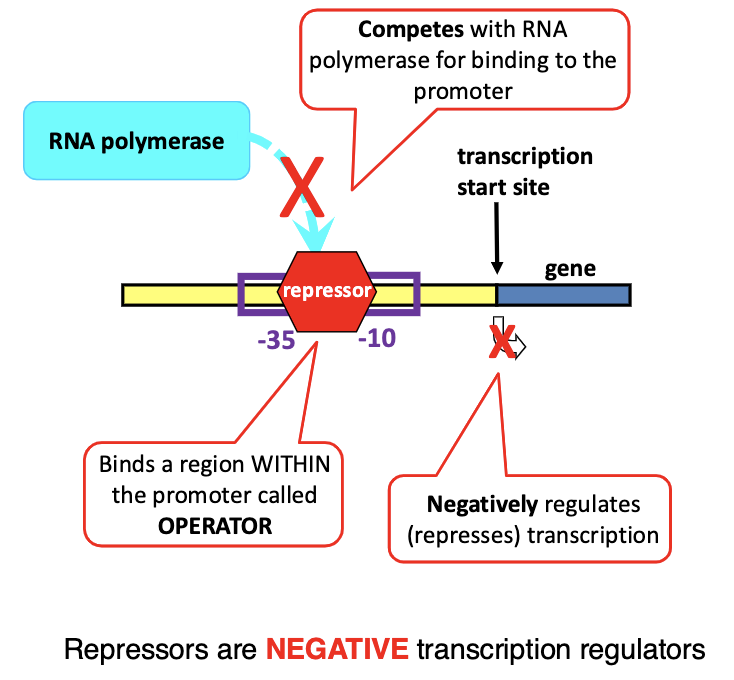
how do repressors work to repress/reduce transcription?
compete with RNA polymerase for binding to the promoter consequently negatively regulates/represses transcription
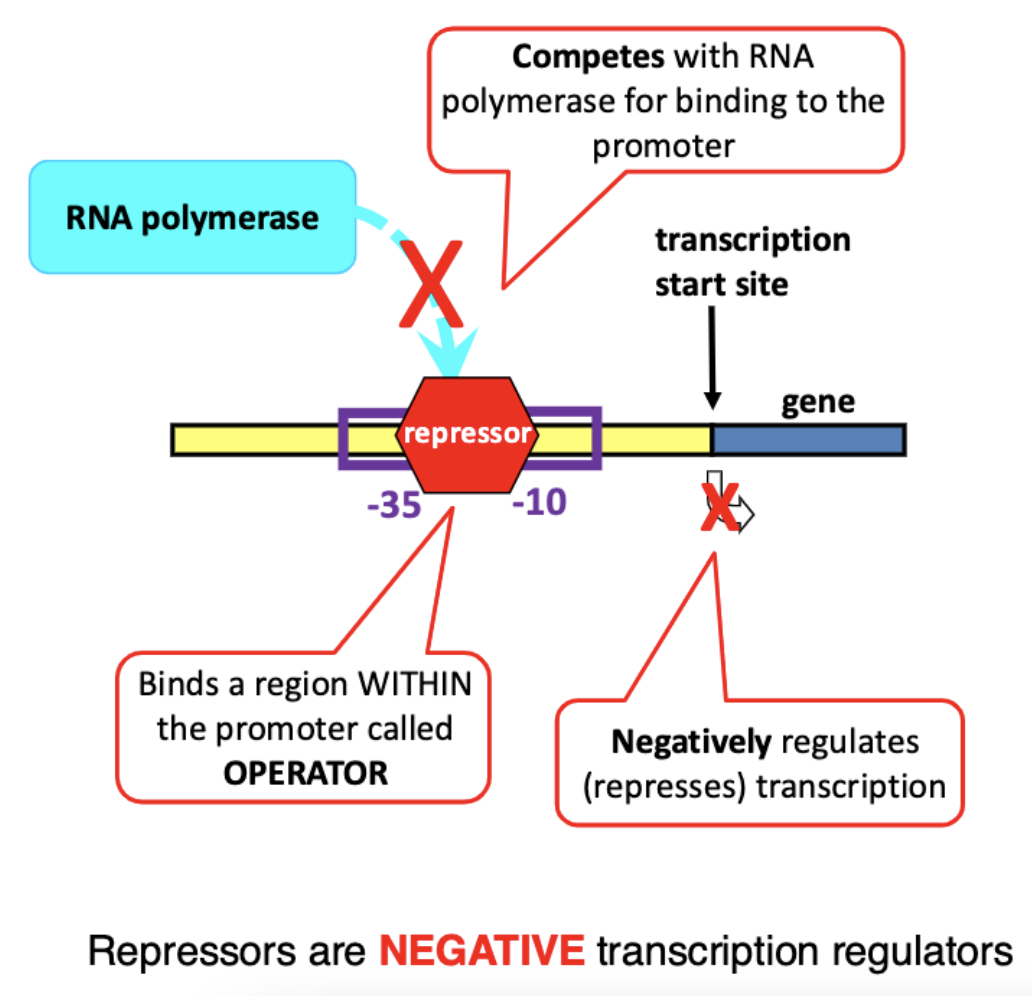
where do activators bind?
binds region upstream of promoter region
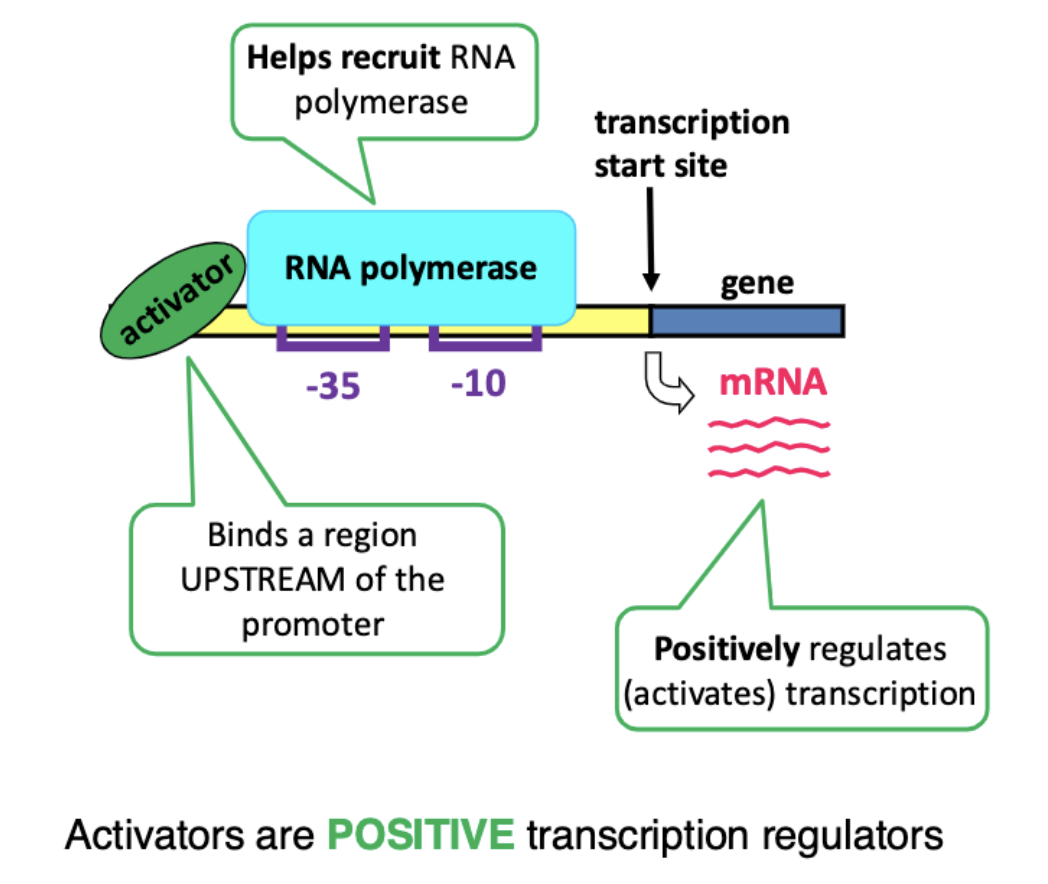
how do activators work to activate transcription?
helps recruit RNA polymerase to positively regulate/activate transcription

Regulators often (but not always) use…?
effectors
function of effectors
allow transcription regulators to sense the environment
do not bind DNA but, instead, bind regulators and change their activity
work as co-repressors, inducers, co-activators
how do Effectors bind transcription regulators and change their activity? (3 kinds of effectors)
co-repressor: Repressor is active only when bound to its co-receptor
inducer: Repressor is inactive when bound to an inducer
co-activator: Activator is active only when bound to its co-activator
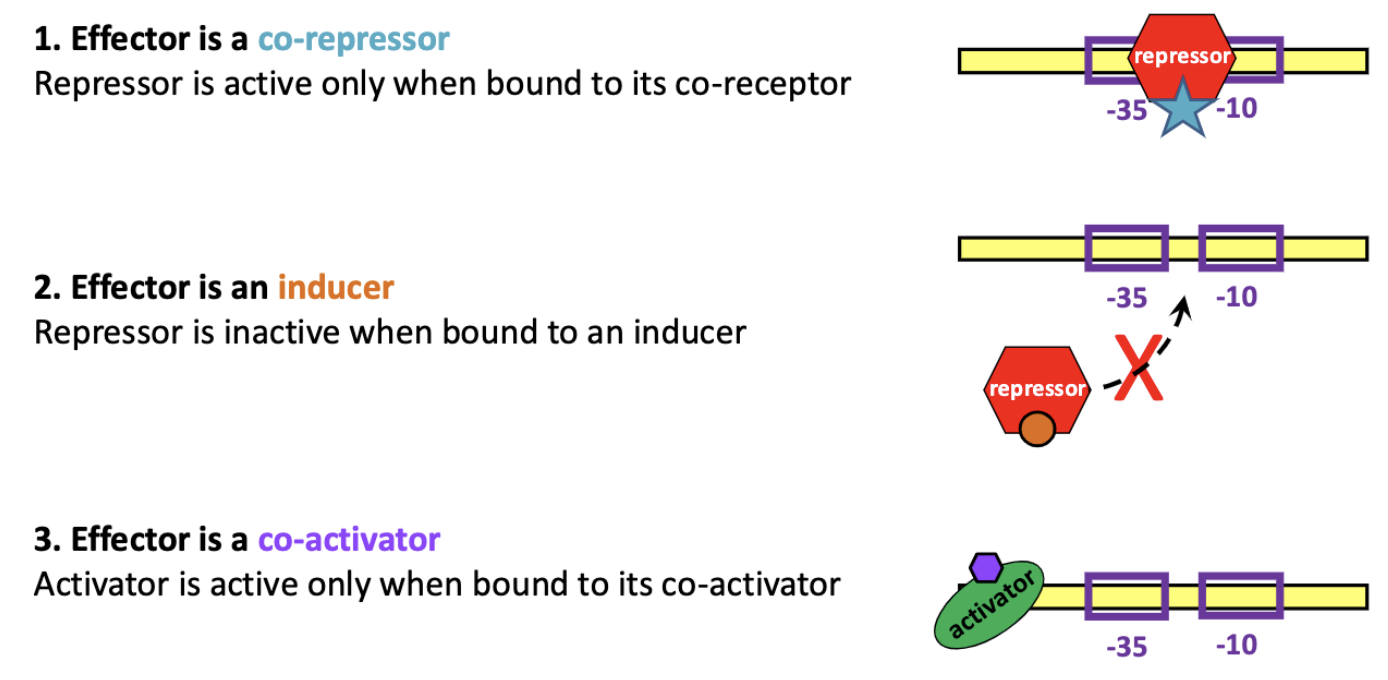
t/f: not all regulators use effectors
true
t/f: A repressor decreases transcription by competing with RNA polymerase for binding to the promoter.
true
t/f: An activator increases gene transcription by binding to the promoter
false. binds upstream of promoter
t/f: Some effectors increase and others reduce transcription.
true
t/f: An effector directly binds DNA
false. binds regulator (repressor or activator)
what is the key regulator of bacterial respiration?
FNR = Fumarate and Nitrate reductase Regulator
function of FNR = Fumarate and Nitrate reductase Regulator
Helps facultative anaerobes to switch from aerobic to anaerobic conditions by functioning as both an activator and repressor
how does FNR = Fumarate and Nitrate reductase Regulator work as a repressor during bacterial respiration?
Represses transcription of aerobic genes, e.g., cytochrome oxidase
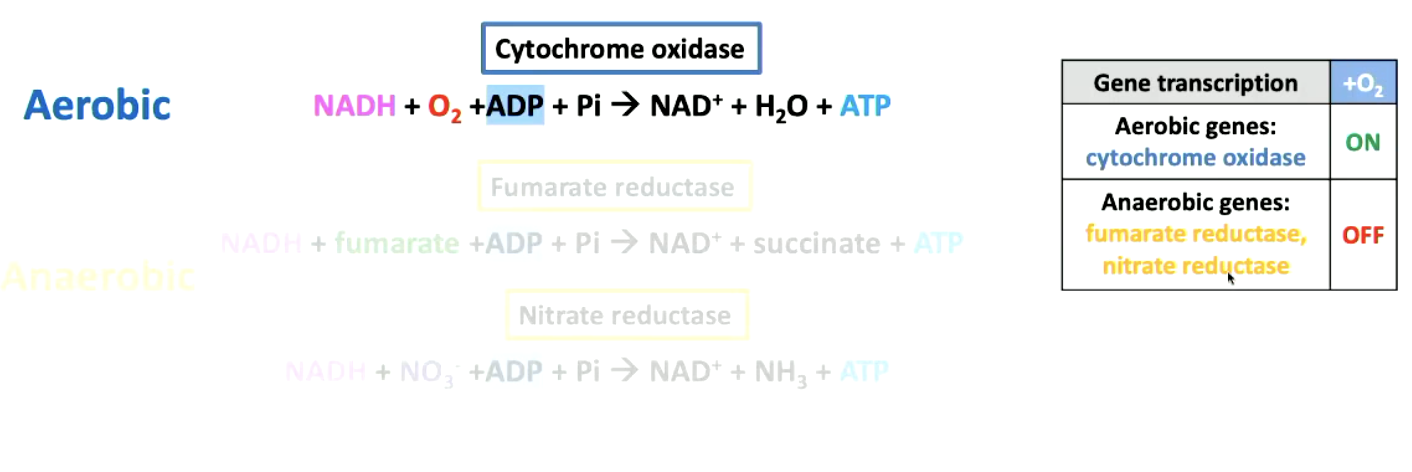
how does FNR = Fumarate and Nitrate reductase Regulator work as an activator during bacterial respiration?
Activates transcription of anaerobic genes, e.g., fumarate reductase and nitrate reductase

Facultative anaerobes (e.g., E. coli) must switch terminal electron acceptors when O2 levels change. How do they do this?
They do it by regulating transcription of ETC genes (FNR = Fumarate and Nitrate reductase regulator)
FNR is only active when?
in the absence of O2 (Uses Fe2+ as an effector (Fe is an O2 sensor))
in anaeobic conditions, what happens to FNR?
it is active and can bind DNA
it can repress transcription (cytochrome oxidase NOT made)
or it can activate (fumarate reductase made in high amounts)
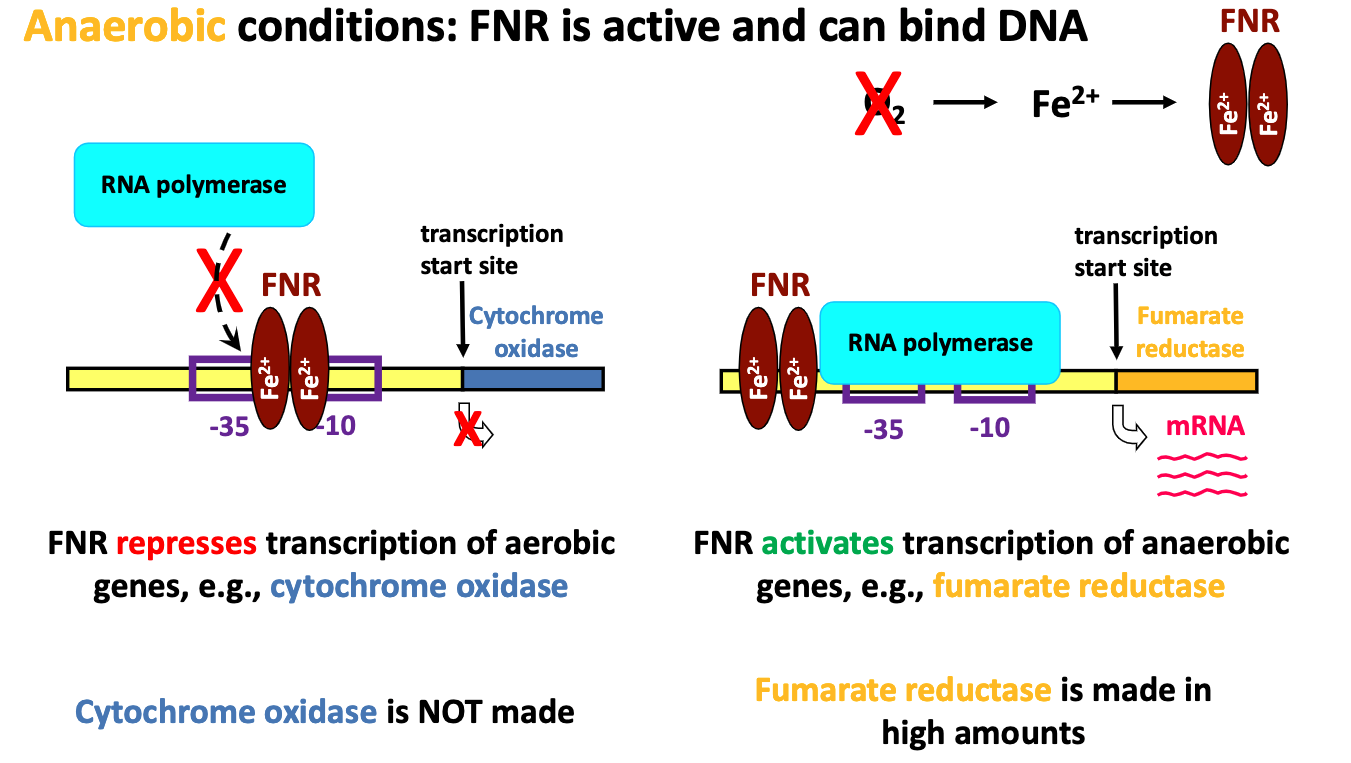
in aerobic conditions, what happens to FNR?
it is inactive and cannot bind DNA
it cannot repress transcription (cytochrome oxidase made in high amounts
or it can activate (fumarate reductase made in high amounts)
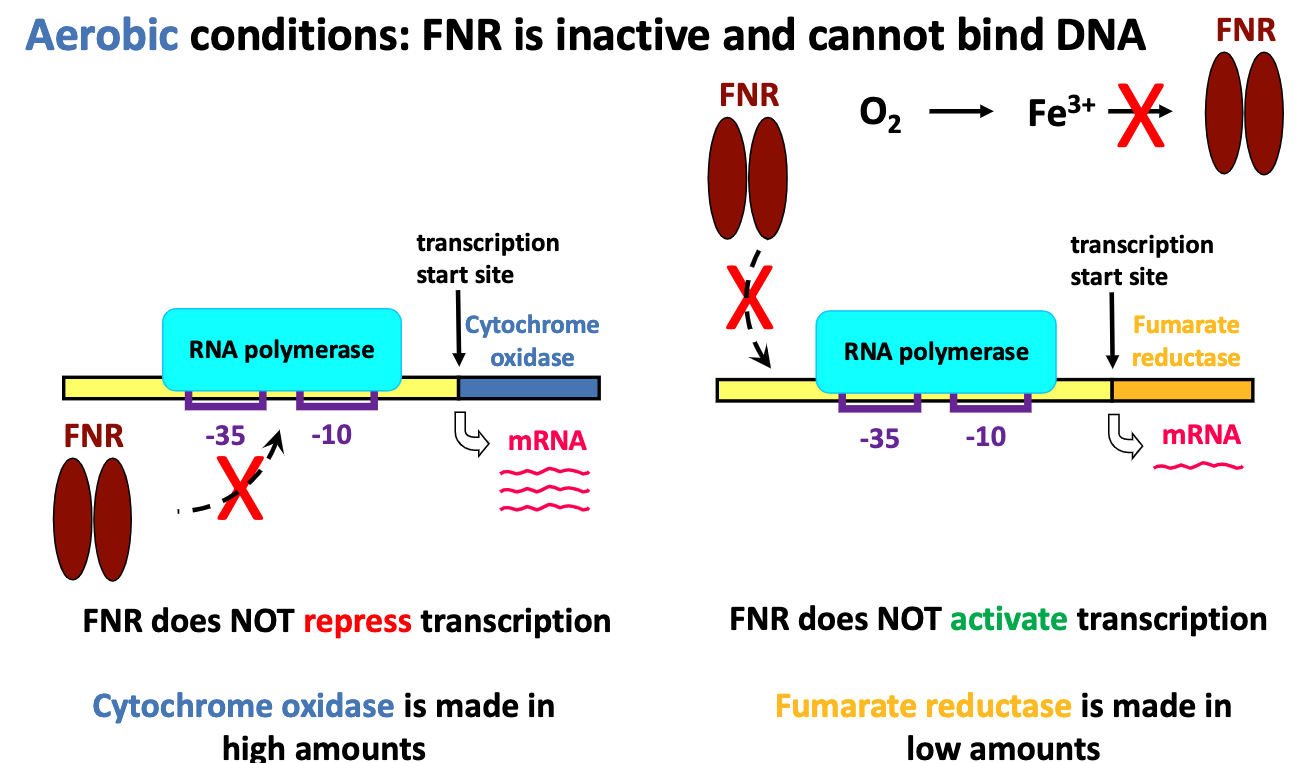
cytochrome oxidase is made only in what conditions? fumarate/nitrate reductase?
cytochrome oxidase → aerobic
fumarate/nitrate reductase → anaerobic
t/f: FNR can both activate and repress transcription.
treu
t/f: FNR is active in the absence of oxygen
true
t/f: FNR is required for facultative bacteria to use O2 as a terminal
electron acceptor under aerobic conditions.
false. only in anaerobic
t/f: FNR uses divalent iron as an effector.
true
t/f: Divalent iron functions solely as a co-activator.
false. also as co-repressor
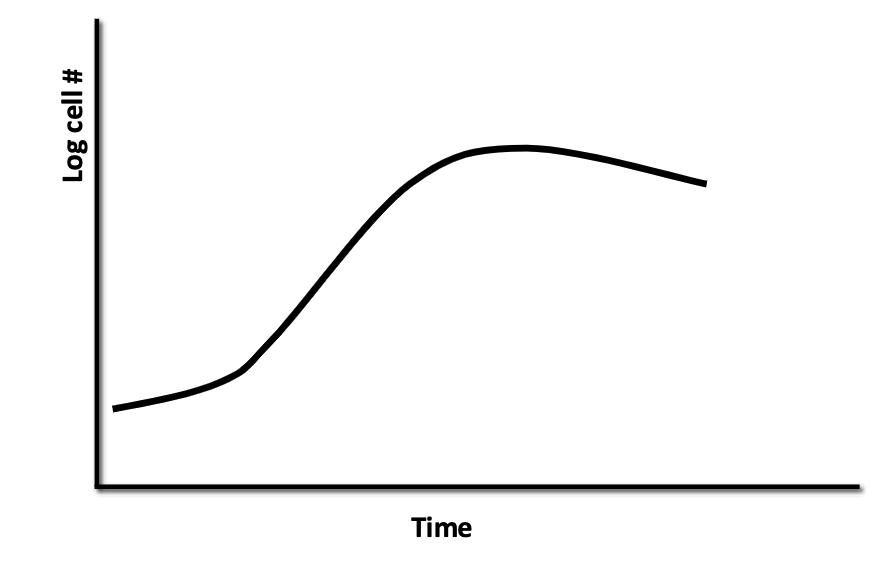
Typical bacterial growth curve with a single carbon source
(e.g., glucose)

Diauxic (biphasic) growth with two different carbon sources (e.g.,
glucose and lactose) in E. coli
bacteria first eat glucose and only then lactose
why are there 2 phases in diauxic (biphasic) growth?
first growth phase continues until all glucose is consumed
during the “break”, bacteria must ramp up expression of lactose metabolism genes
second growth phase resumes until lactose is consumed
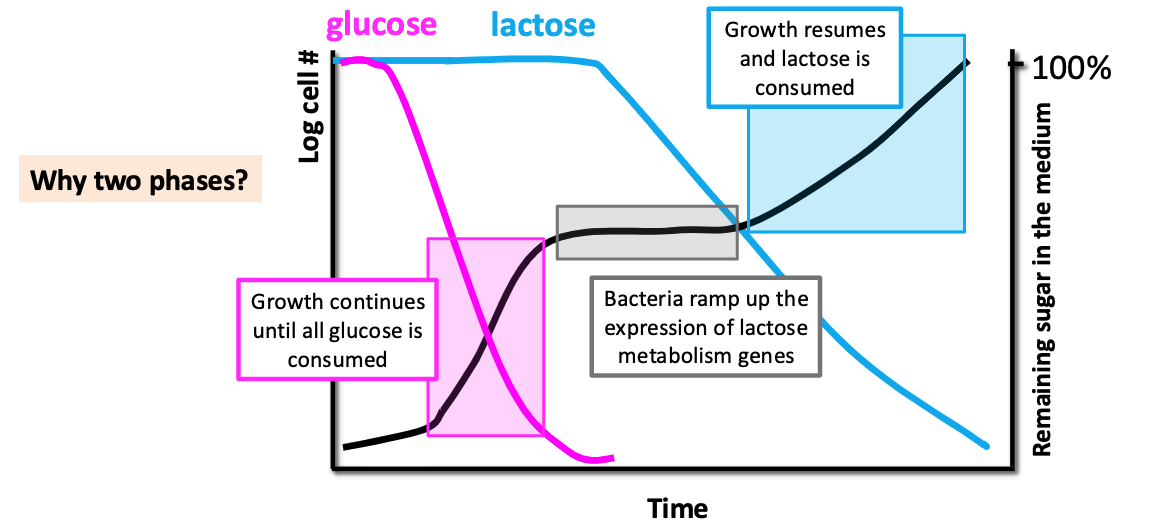
Why do E. coli prefer glucose?
Breaking down glucose requires fewer steps and less energy. Extra steps are required to break down lactose
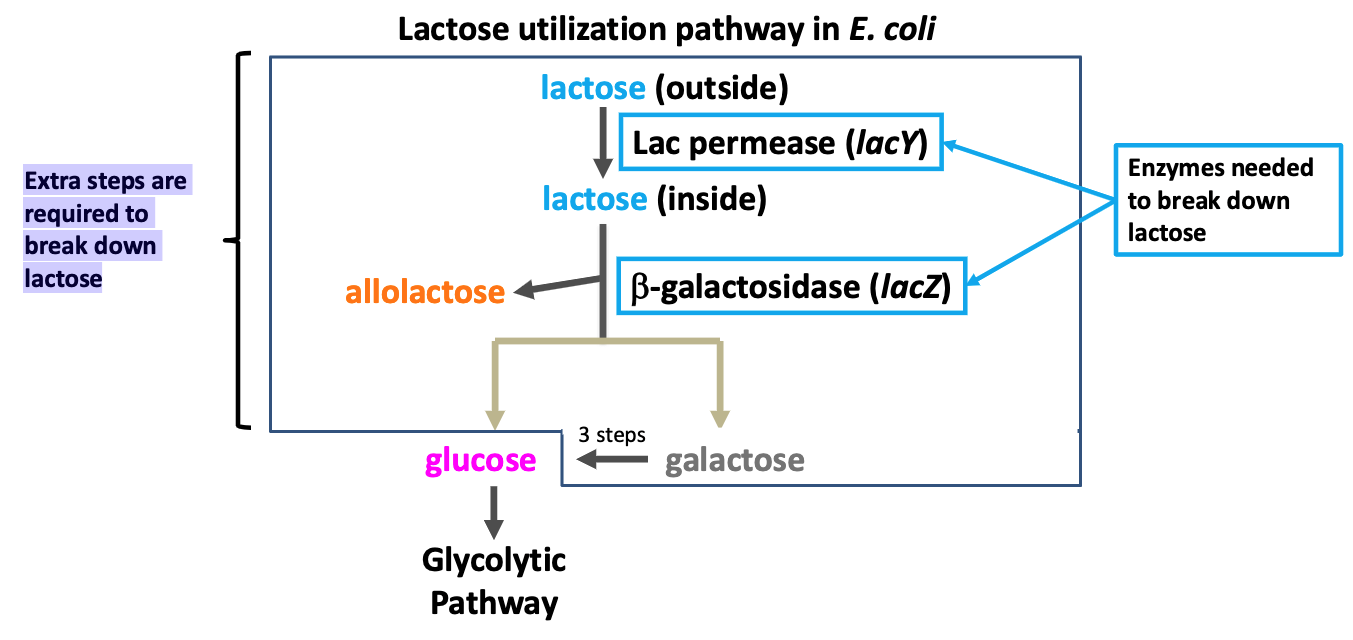
what enzymes are needed to break down lactose into glucose? and what genes encode these enzymes?
lac permease (lacY)
beta-galactosidase (lacZ)
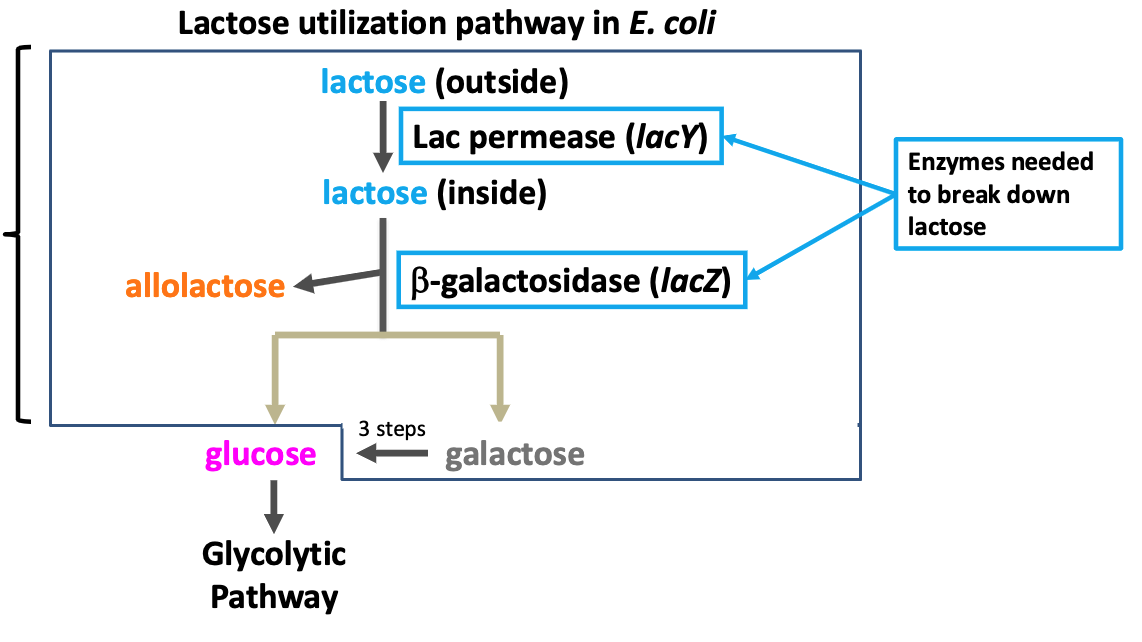
E. coli have evolved regulatory mechanisms to metabolize
glucose before lactose (or any other sugar). When glucose is available, do E. coli make the enzymes required for lactose metabolism?
no
the lac operon is transcribed only when…?
lactose is available, but glucose is NOT available (to increase efficiency and reduce energy consumption)
The lac operon consists of 3 genes encoding 3 enzymes that allow E. coli to use lactose as an energy source. What are these genes and enzymes?

How do E. coli detect lactose vs glucose?
there are Two regulators that regulate transcription of the lac operon by sensing lactose vs. glucose:
LacI repressor → senses lactose
CAP (catabolite activator protein) → senses glucose
where does LacI bind and what does it bind to?
promoter reion of lac operator
binds allolactose (an inducer/product of lactose metabolism)
what does LacI do in the absence of lactose?
LacI binds lac operator and represses transcription of the lac operon
the enzymes to break down lactose are not made
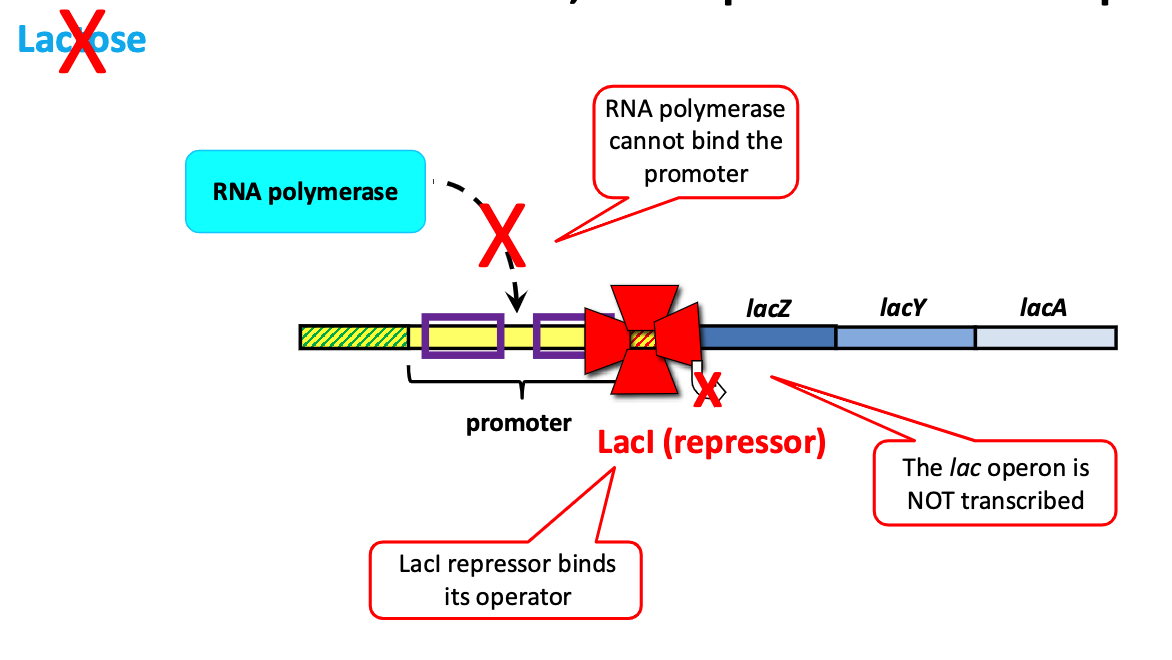
what does LacI do in the presence of lactose?
Allolactose is made
LacI binds allolactose and is inactive (cannot bind lac operator)
The enzymes to break down lactose are made, but only at low levels
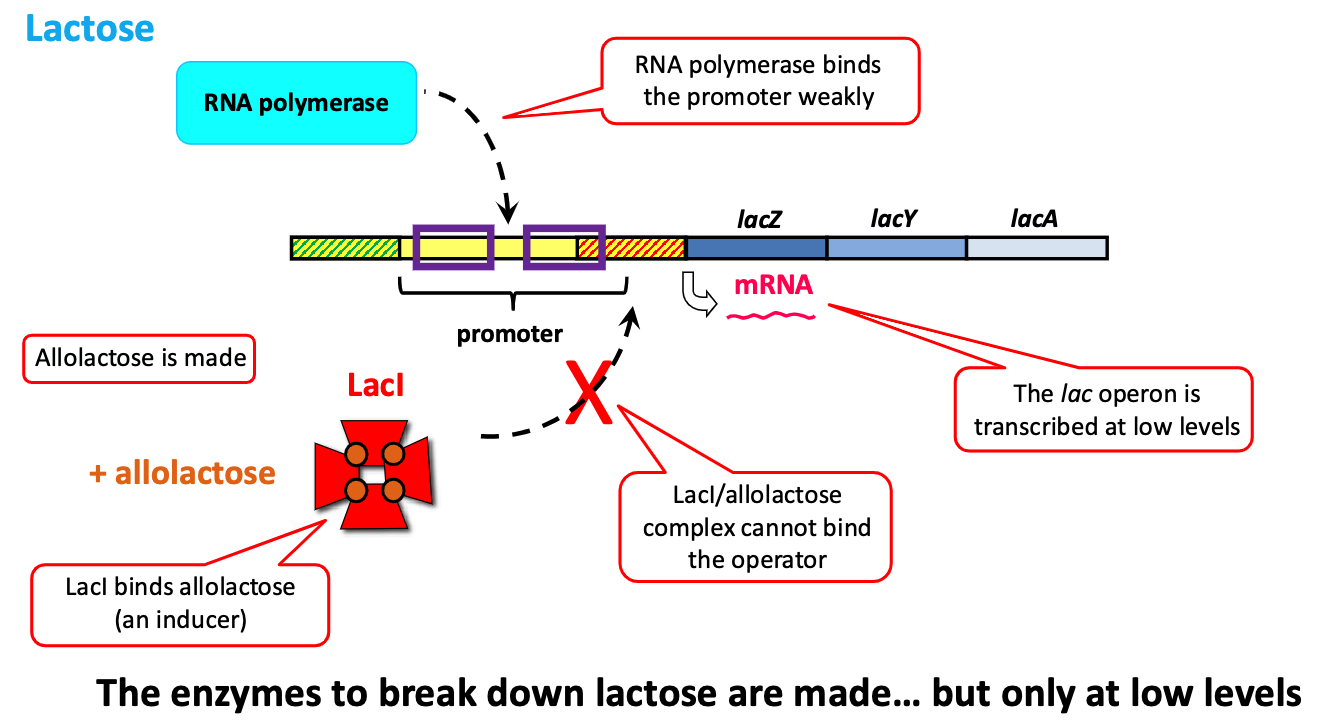
in presence of lactose, LacI is active/inactive.
in absence of lactose, LacI is active/inactive.
in presence of lactose, LacI is inactive.
in absence of lactose, LacI is active, binds operator, represses
transcription.
what is CAP?
activator and glucose sensor
where does CAP bind and what does it bind to?
Binds upstream of the lac promoter
Binds cAMP (a co-activator), produced when glucose is low

what does CAP do when glucose levels are high?
CAP is inactive (because very little cAMP is made)
The enzymes to break down lactose are made, but only at low levels
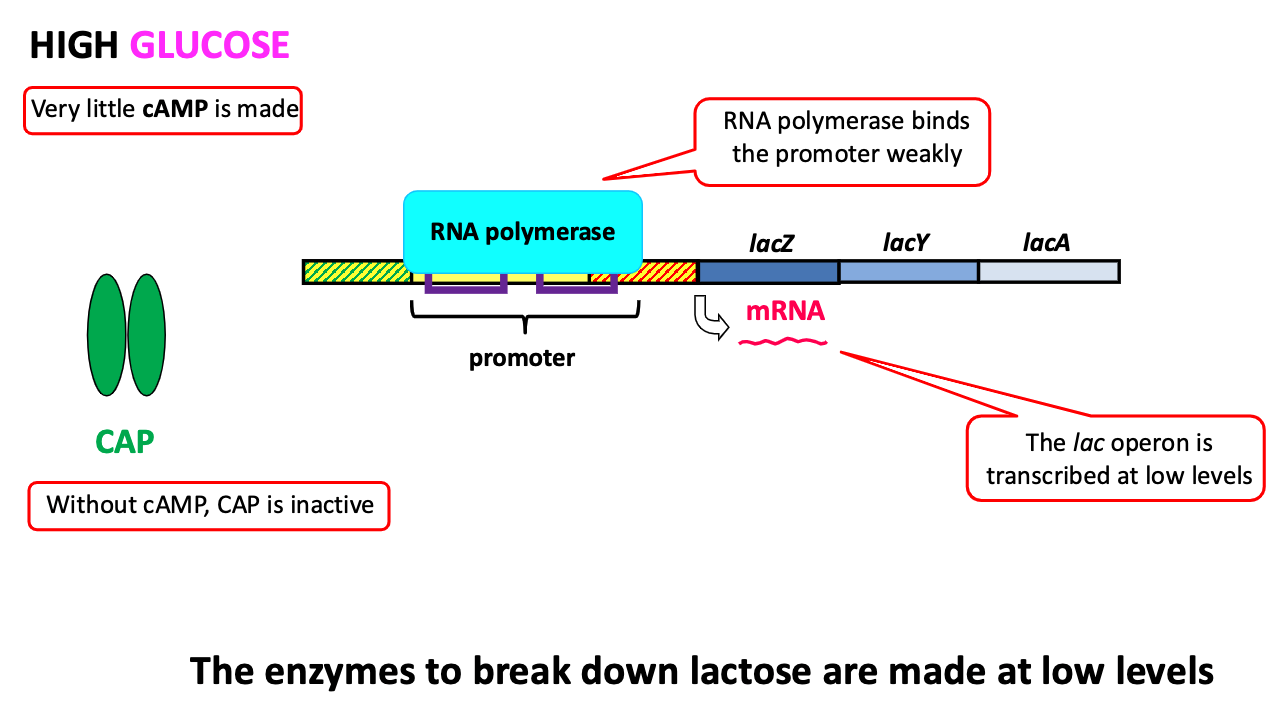
what does CAP do when glucose levels are low?
cAMP is made (a “hunger” signal)
CAP binds cAMP and activates transcription of the lac operon
The enzymes to break down lactose are made at high levels
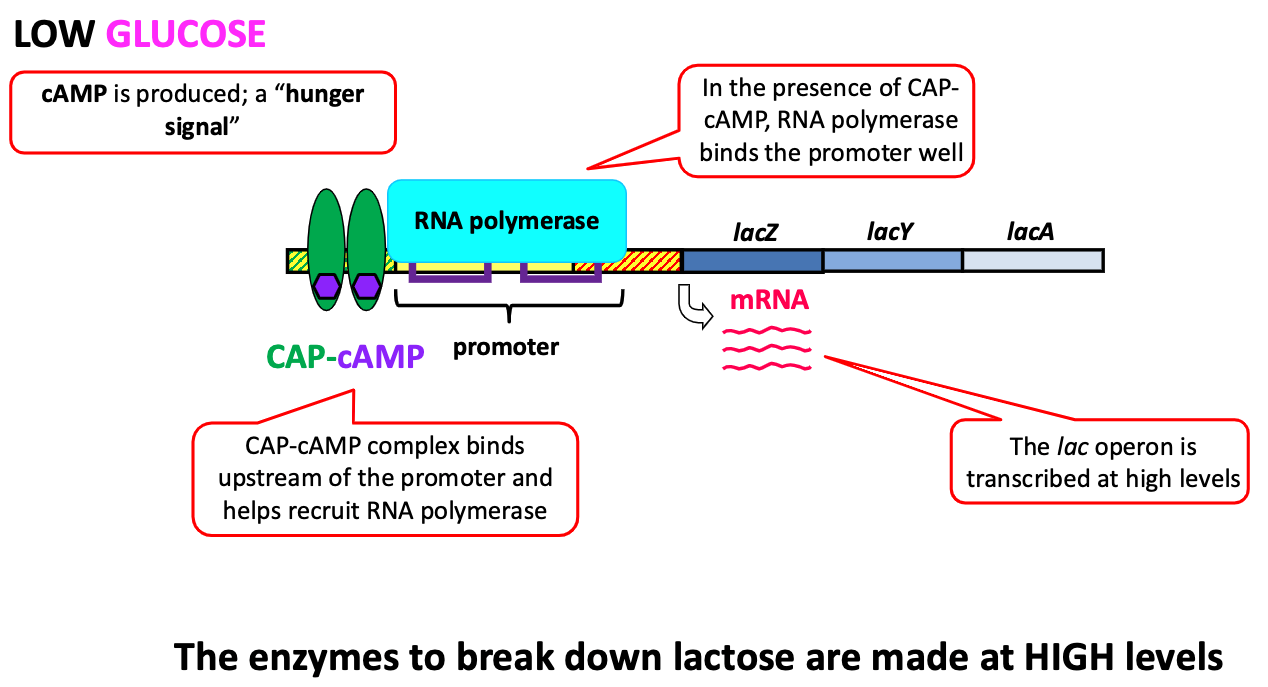
in high levels of glucose, CAP is active/inactive.
in low levels of glucose, CAP is active/inactive.
in high levels of glucose, CAP is inactive.
in low levels of glucose, CAP is active, binds CAP-binding site,
activates transcription
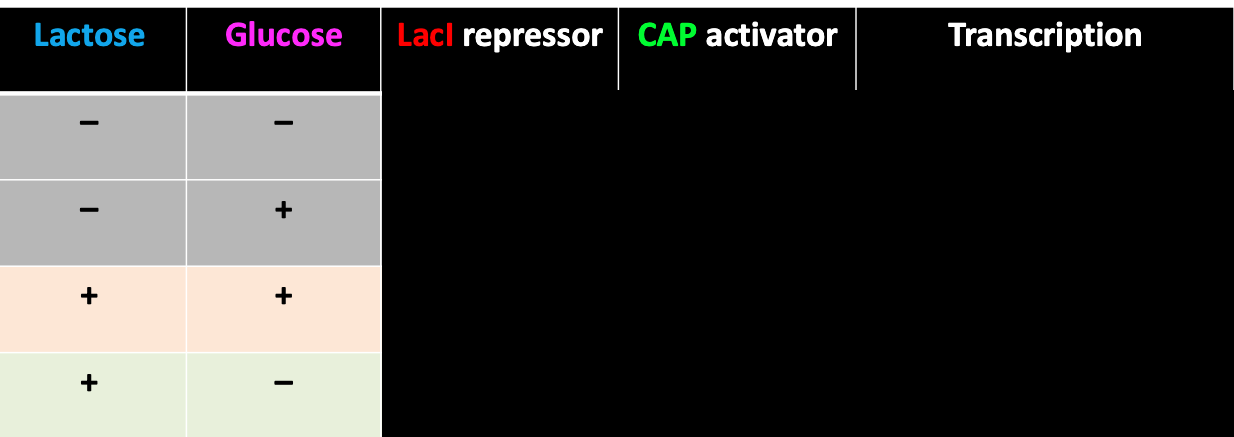

t/f: Diauxic bacterial growth of E. coli can be observed whenever
glucose is present with any other sugar.
false
t/f: E. coli consumes glucose first because it is easier to
metabolize
true
Is growth on two sugars always diauxic (biphasic)?
no. can be monophasic such as w glucose + sucrose
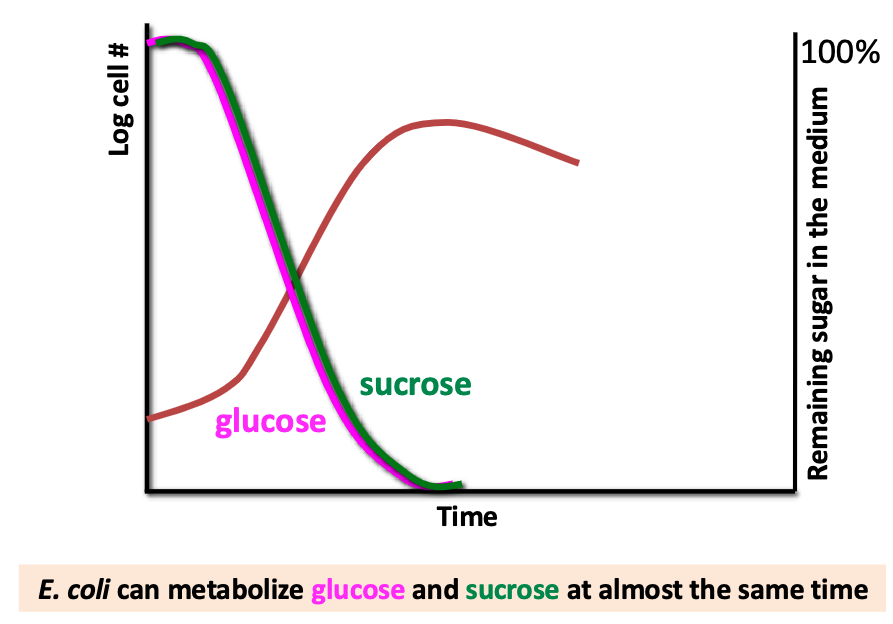
t/f: The LacI repressor senses lactose but not glucose
true
t/f: A single transcriptional regulator controls expression of the
lactose metabolism genes in E. coli.
false. LacI and CAP (2)